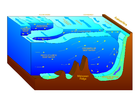- Deep ocean water
-
Deep Ocean Water (DOW) is the name for cold, salty water found deep below the surface of Earth's oceans. Ocean water differs in temperature and salinity, with warm, relatively non-salty water found at the surface, and very cold salty water found deeper below the surface layer. Deep ocean water makes up about 90% of the volume of the oceans. Deep ocean water has a very low temperature, with a high of 1.6 °C (35 °F), and a salinity of about 3.5%.
In specialized locations such as the Natural Energy Laboratory of Hawaii NELHA ocean water is pumped to the surface from approximately 3000 feet deep for applications in research, commercial and pre-commercial activities. DOW is typically used to describe ocean water at sub-thermal depths sufficient to provide a measurable difference Delta in water temperature.
When deep ocean water is brought to the surface, it can be used for a variety of things. The most useful property of it is its temperature. At the surface of the Earth, most water and air is well above 1.6°C. The difference in temperature is indicative of a difference in energy. Where there is an energy gradient, skillful application of science and engineering can harness that energy for productive use by humans. Assuming the source of deep ocean water is environmentally friendly and replenished by natural mechanisms, it forms a more innovative basis for cleaner energy than current fossil-fuel-derived energy.
The simplest use of cold water is simply for air conditioning: using the cold water itself to cool air saves the energy that would be used by the compressors for traditional refrigeration. Another use could be to replace expensive desalination plants. When cold water passes through a pipe surrounded by humid air, condensation results. The condensate is pure water, suitable for humans to drink or for crop irrigation. Finally, via a technology called Ocean thermal energy conversion, the temperature difference can be turned into electricity.
See also
Categories:
Wikimedia Foundation. 2010.


